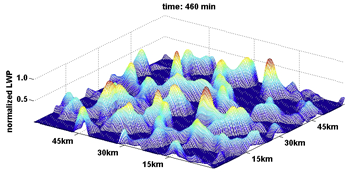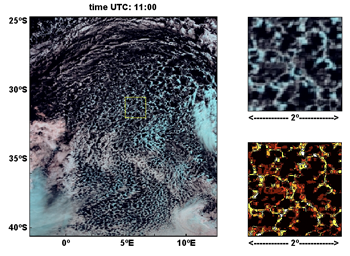2010 News & Events
Uncovering Oscillating Patterns in Clouds
18 August 2010



A new NOAA study has found that rain clouds form synchronous patterns in which individual clouds in a large cloud field respond to signals from other clouds, much like chirping crickets or flashing fireflies on a summer night. The study published online 12 August in the journal Nature also has significant implications for our understanding of climate change research.
This research, led by CSD's Graham Feingold, shows for the first time that interactions between certain types of neighboring clouds can result in synchronized rain patterns within a large cloud system.
"Clouds organize in distinct patterns that are fingerprints of myriad physical processes," Feingold explained. "Precipitation can generate fascinating honeycomb-like patterns that are clearly visible from satellites. Cloud fields organize in such a way that their components 'communicate' with one another and produce regular, periodic rainfall events."
While the discovery of synchronized behavior in clouds is one of many recent findings on self-organization in nature, the study also examines how suspended particles, or aerosols, in the atmosphere can influence these patterns and be a factor in climate change.
The team, which also includes Ilan Koren of the Weizmann Institute, Hailong Wang of Pacific Northwest National Laboratory, Huiwen Xue of Peking University, and Alan Brewer of NOAA ESRL CSD, used satellite imagery to identify cloud systems with a "cellular, almost honeycomb-like structure." In such systems, thick clouds form the walls of the honeycomb, and cloud-free zones form the open cells between the walls. The team also observed that these cellular structures constantly rearrange themselves, with cloud walls dissolving and open cells forming in their place, while walls form where open cells once existed.
Using computer models, the scientists reproduced this rearrangement or oscillation of the cloud honeycomb pattern, and identified the driving factor – rain. Next, they analyzed scanning laser measurements from a ship cruising under cloud systems to verify their model results.
"Together, these analyses demonstrated that the rearrangement is a result of precipitation, and that clouds belonging to this kind of system rain almost in unison," Feingold said.
How does this synchronization come about? Falling rain cools the air as it descends. This creates downward air currents. These downdrafts hit the surface, flow outward and collide with each other, forming updrafts. The air flowing up creates new clouds in previously open sky as older clouds dissipate. Then the new clouds rain, and the oscillating pattern repeats itself.
"Once precipitation ensues and an open structure has formed, it is difficult to revert the cloud field to a closed-cell, or overcast state," Feingold said. "Rain keeps the oscillating, open honeycomb pattern in motion, which allows more sun to reach Earth's surface."
The scientists say that their findings point to a significant influence of particulate matter, or aerosols, on the large-scale structure of clouds and therefore on climate change. Scientists have long known that aerosols can influence local rain formation and block solar energy from reaching the Earth's surface – for an overall surface cooling effect.
However, until recently, the scientific community has not considered the self-organization that results from these effects. Computer simulations for this study indicate that high aerosol concentrations favor the formation of large, dense cloud fields with less open space and less rain. This creates a more reflective cloud pattern and cooling of the surface. Low particulate levels in computer models resulted in rain and the open honeycomb structure with an oscillating pattern. The open honeycomb structure in a large cloud field lets more sunlight reach the surface, and hence results in surface warming.
"Our work also suggests that we should expand our thinking about interactions between aerosols and clouds," Feingold said. "Integrating our current focus on fundamental physical processes with broader studies on system dynamics could give us a more complete understanding of climate change."
Graham Feingold, Ilan Koren, Hailong Wang, Huiwen Xue, Wm. Alan Brewer, Precipitation-generated oscillations in open cellular cloud fields Nature, doi:10.1038/nature09314, 2010.